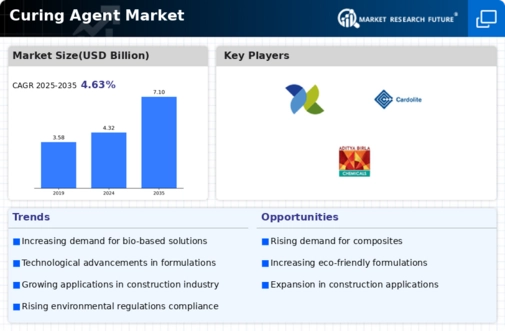Top Industry Leaders in the Curing Agent Market

The global curing agent market is a simmering cauldron of competition. Players jockey for position, their strategies as diverse as the types of resins they harden. Let's delve into the ingredients swirling within this market, the factors determining dominance, and the recent developments keeping it bubbling hot.
Strategies Unleashing Market Magic:
-
Ingredient Innovation: Leading players like Evonik and BASF aren't content with conventional formulas. They're brewing up eco-friendly bio-based curing agents and experimenting with high-performance options like low-odor and rapid-curing varieties. -
Application Focus: Catering to specific needs is key. Huntsman tailors its offerings for the booming composites industry, while Hexion specializes in coatings and adhesives, each leveraging their expertise to secure market share. -
Regional Delights: Understanding regional tastes is crucial. Olin Corporation caters to the price-sensitive North American market with affordable options, while Mitsubishi Chemical Corporation focuses on high-tech solutions for the demanding Asian market. -
Vertical Integration: Some players, like Dow Chemical, are expanding their hold on the recipe chain, acquiring mines for raw materials and establishing downstream operations to gain control over costs and quality. -
Collaboration Concoctions: Open innovation is brewing exciting partnerships. Evonik and Arkema join forces to develop next-generation curing agents, while startups collaborate with research institutions to accelerate innovation.
Factors Dictating Market Share:
-
Ingredient Purity and Performance: Players like BASF, known for their high-quality and reliable curing agents, inspire trust and command premium prices. -
Product Portfolio Breadth: Offering a diverse range of solutions like amines, anhydrides, and light-activated curing agents, like Henkel does, caters to varied customer needs and applications. -
Technical Expertise and Customer Support: Deep knowledge of curing agents and their applications, like Huntsman's technical support and training programs, provide value beyond the product itself. -
Sustainability Savvy: Eco-conscious customers favor bio-based and low-VOC curing agents. Players like Lanxess, with their green initiatives, attract this growing segment. -
Regulatory Awareness and Compliance: Adherence to safety and environmental regulations, like CE marking, opens doors to new markets and builds trust.
Key Players:
Evonik Industries AG (Germany)
BASF SE (Germany)
Huntsman International LLC (US)
Hexion (US)
Olin Corporation (US)
Cardolite (US)
Aditya Birla Chemicals (India)
Mitsubishi Chemical Corporation (Japan)
Atul Ltd (India)
Albemarle Corporation (US)
GABRIEL (US)
Campbell Plastics (UK)
Arnette Polymers LLC (US)
Cargill Incorporated (US)
Epochemie International Pte Ltd (Singapore)
KUMIAI CHEMICAL INDUSTRY CO. LTD. (Japan)
LEUNA-Harze GmbH (Germany)
Recent Developments:
-
September 2023: Researchers develop a light-activated curing agent that hardens within seconds, opening up possibilities for rapid prototyping and 3D printing applications. -
October 2023: A major automotive manufacturer switches to a bio-based curing agent for its interior components, further driving green solutions in the market. -
November 2023: The American Society for Testing and Materials updates its standards for testing curing agents, raising the bar for quality and safety. -
December 2023: Startups emerge offering AI-powered software to optimize curing agent selection and application processes, bringing digital intelligence to the market.









